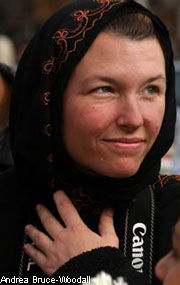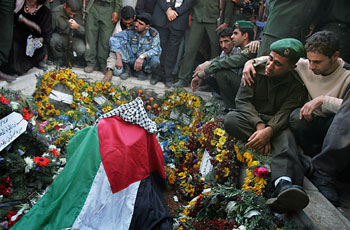 |
 | |||||||||||||
Arafat
December 2004
|
 |
||||||||||||
|
With his two major goals unsatisfied -- a Palestinian state and a grave waiting for him in Jerusalem - Yasser Arafat was buried amid chaos in a temporary grave inside the Muqata, his half-demolished compound in Ramallah. Covering the lead up to his death in the Palestinian Territories and then the burial in Ramallah, was an experience of a lifetime, yet one of the hardest things I have ever photographed. For 15 days we waited for any expression of love or hate from the Palestinians while their leader approached death. All we got was silence. My translator in Gaza said people were just in shock that the only leader some had ever known was passing.
Shortly afterwards, I traveled to Ramallah for Arafat's burial. I expected a similarly muted reaction. Because Arafat died as head of state, however ambiguous the state as Palestine, I planned to cover a tightly controlled event. AP and Reuters had been selected for pool, an unfortunate discovery for me, assigned to cover the historic burial for TIME magazine. By 11 am large crowds began to gather outside the compound for the afternoon service. As the minutes passed the front entrance to the Muqata started to resemble the front rows a rock concert, people excitedly crammed together trying to get as close as possible.
I landed intact, but my palms felt like they were on fire, because the skin was largely scrapped off in my descent. When I cleared the rubble and could see the vast Muqata courtyard, every inch seemed filled with mourners and onlookers. Unsure how to position myself as there was no publicized schedule of what was supposed to happen, I moved through the crowd, feet barely touching the ground, until I was able to find a suitable position. I perched myself on top of a building near the entrance of the compound to try to capture the fury on the ground. I watched from above as people screamed, pushed and shoved each other. When the Egyptian helicopters carrying Arafat's body finally landed, any rules of appropriate social behavior still being observed finally broke.
On the ground, as I tried to move through the crazed mob, I was groped repeatedly - my stomach, butt and breasts felt by young men in the crowd. I felt violated but there was no one to blame. Every time I turned around, it seemed there was no one in specific to yell at. It was just a sea of moving bodies and faces. So I kept trying find the coffin, which I knew was moving over the heads of the people. It was just too crowded, and being 5'2'', I was too short to see anything. Even my "hail Mary" attempts were fruitless.
In the end, at least two Palestinians died in the chaos, one fell off a building and the other was struck by a stray bullet. Palestinian medical officials reported 120 people injured, 4 from shrapnel and stray bullets. When I woke up the next morning I felt like I had played a five-hour rugby game. I was exhausted and glad it was over. I don't know exactly what the day's events say about the future for the Palestinians, but it surely shows that there is a lot more work to be done here before there is peace. The extreme lack of emotion in the buildup and death of their leader and then the intensity of the burial also made it clear to me that Arafat was deeply loved and maybe deeply hated by many people.
© Stephanie Sinclair
Dispatches are brought to you by Canon. Send Canon a message of thanks. |
|||||||||||||
Back to December 2004 Dispatches
|
|




